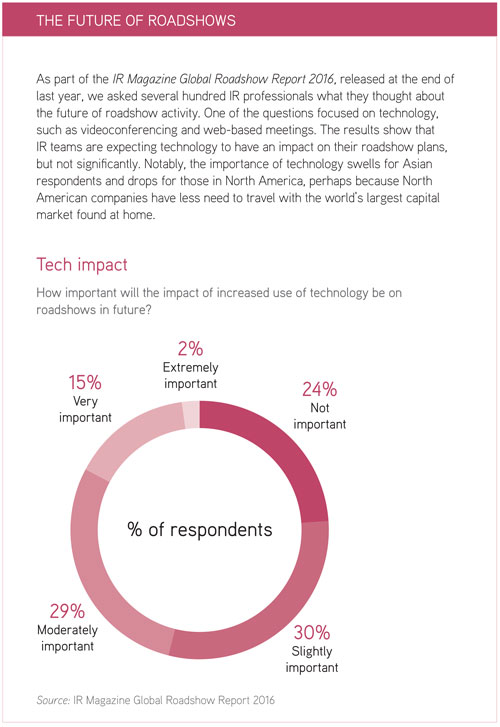How are IROs using online meetings to make the most of their corporate access events?
For IROs with dwindling budgets, shrinking team sizes and less time on their hands, online meetings seem to offer the cost and time-effective solution of meeting global investors from the comfort of a computer chair. In reality the practice has not quite gone mainstream; finance departments might deem the technology too expensive, investors may not be comfortable communicating online, or an IRO’s audience may just be used to the usual points of contact.
Still, adoption is edging upwards. OpenExchange, a provider of virtual meetings solutions for capital markets participants, reports that the number of users of its online community has risen to more than 1,000. In addition, around 10,000 shareholders were taking part in 2016 – a significant increase on figures recorded over the previous two years.
IROs surveyed as part of the IR Magazine Global Roadshow Report 2016, which was released last November, believe the increased use of technology, including videoconferencing and other web-based meetings, will have a noticeable impact on their roadshow activity. Only 24 percent of the 730 professionals surveyed say the use of technology for meetings will not be important at all, while 46 percent describe technology as at least moderately important.
Screen pioneers
Companies that have used video technology effectively say they are expanding the impact of their in-person events. In general, these trailblazing teams are those with a relatively new shareholder base, whether due to a recent IPO or newly created industry, or an audience that is already tech-savvy.
One such company is US telecoms giant Cisco: since 2006 it has used its own videoconferencing product, Cisco TelePresence, to communicate with top shareholders via post-results one-to-one meetings and as part of virtual investor roadshows. Such technology, also employed by some brokerage firms, presents virtual guests in life-size form, often sitting at a table across the room.
Marilyn Mora, the firm’s head of global investor relations, says she also uses video-based collaboration tools, such as the company’s own Webex and Spark platforms, on a more informal basis to ‘increase the effectiveness’ of other in-person events. These solutions allow the IR team to see the ‘body language and non-verbal cues’ of far-flung investors, she says, which is ‘critical to understanding whether our messages are resonating.’ Furthermore, it allows Cisco to manage and grow its investor base beyond the limits previously imposed by time and resources, she adds.
More digital solutions are used to boost Cisco’s analyst day and other educational events for shareholders, such as a live webcast that allows website visitors to tune in. Recordings are kept online for a year for people who couldn’t make it on the day, or those who want to refresh their understanding of the company. Feedback from investors about Cisco’s use of video for investor meetings has been ‘very positive,’ says Mora, as they enjoy having access to management on a more frequent basis.
Nicole Maselli, head of sales at OpenExchange, says other popular uses of videoconferencing technology include opening up meetings to key corporate operators, such as R&D or departmental heads, and conducting a virtual non-deal roadshow. One of her clients, a European car maker with a DR listing, uses videoconferencing to allow its CFO to set aside time for virtual one-on-ones with top US investors and targets.
Maselli also mentions a large-cap industrials company that asked one of its research analysts to assemble a group video meeting in order to onboard its new CEO, rather than ‘going quiet’ with the investment community while he caught up. Both the new chief executive and existing CFO met a mixture of top investors and targets to share their new vision for the company and to field early questions from investors that were keen to feel out the new executive.
Not for everyone
That’s not to say that taking investor meetings online is necessarily right for every company, however. One major stumbling block is that in most cases the demand from investors is not quite there – this can be due to a lack of comfort, familiarity or even interest in using the required technology.
Newer entrants to the investment world may be less uptight about being in the same room as management. ‘We’ve found that millennials tend to be more comfortable communicating via video,’ says Mora, who has increased Cisco’s use of video for IR purposes as her investor base shifts toward younger stakeholders.
Some participants are uncomfortable using the video aspect of these platforms – and being seen on the big screen – so tend to use the audio portion of the meetings extensively. Audio-only transcripts are still the most widely palatable way to catch up on a missed event, notes Mora, though she says it’s good to remain flexible so you can ensure an ‘effective and optimal meeting experience that drives value for investors.’
Another problem for investors can be the technology actually working on the day, whether due to bugs in the system or a patchy internet connection. Mora reminds IROs to trial and test any online platform – particularly bandwidth-intensive videoconferencing programs – prior to the event to ensure voice and audio quality are working as expected.
Video is slowly, but surely, increasing its presence in IR activity. That’s run of the mill for an industry where technology is adopted cautiously. The main trick for success, according to those already making the most of video, is to ensure all the investors involved in the meeting have a complete and comparable experience, whether they are sat in the room or joining virtually from the other side of the world.

This article appeared in the summer 2017 issue of IR Magazine.










